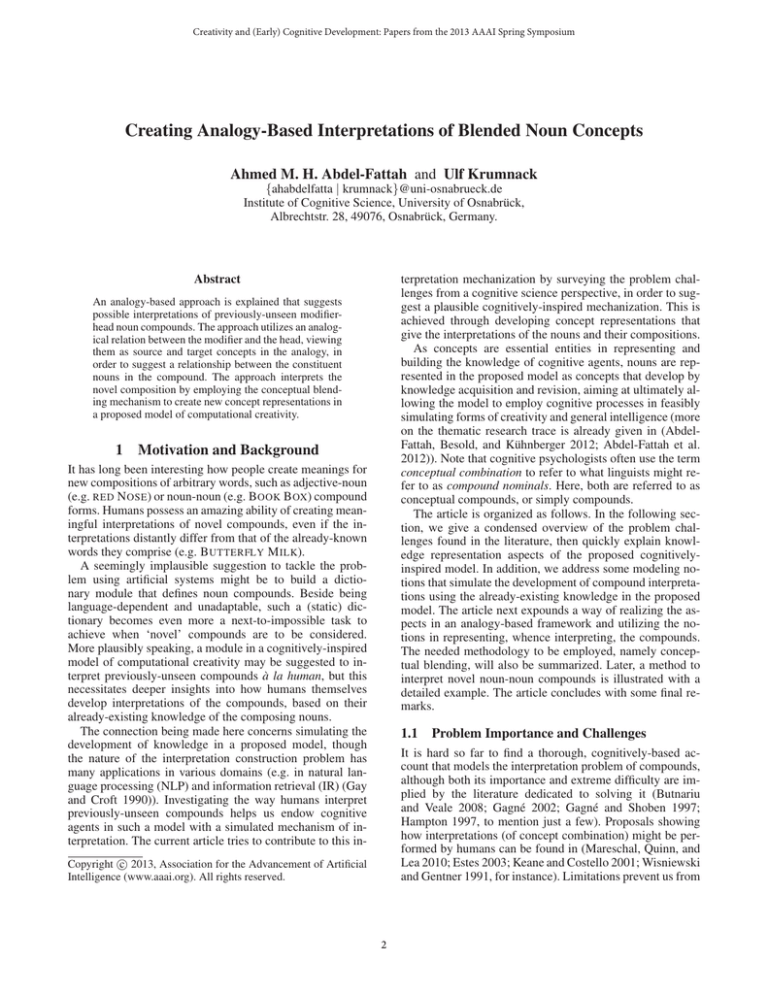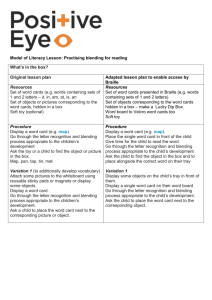Creating Analogy-Based Interpretations of Blended Noun Concepts
advertisement

Creativity and (Early) Cognitive Development: Papers from the 2013 AAAI Spring Symposium
Creating Analogy-Based Interpretations of Blended Noun Concepts
Ahmed M. H. Abdel-Fattah and Ulf Krumnack
{ahabdelfatta | krumnack}@uni-osnabrueck.de
Institute of Cognitive Science, University of Osnabrück,
Albrechtstr. 28, 49076, Osnabrück, Germany.
Abstract
terpretation mechanization by surveying the problem challenges from a cognitive science perspective, in order to suggest a plausible cognitively-inspired mechanization. This is
achieved through developing concept representations that
give the interpretations of the nouns and their compositions.
As concepts are essential entities in representing and
building the knowledge of cognitive agents, nouns are represented in the proposed model as concepts that develop by
knowledge acquisition and revision, aiming at ultimately allowing the model to employ cognitive processes in feasibly
simulating forms of creativity and general intelligence (more
on the thematic research trace is already given in (AbdelFattah, Besold, and Kühnberger 2012; Abdel-Fattah et al.
2012)). Note that cognitive psychologists often use the term
conceptual combination to refer to what linguists might refer to as compound nominals. Here, both are referred to as
conceptual compounds, or simply compounds.
The article is organized as follows. In the following section, we give a condensed overview of the problem challenges found in the literature, then quickly explain knowledge representation aspects of the proposed cognitivelyinspired model. In addition, we address some modeling notions that simulate the development of compound interpretations using the already-existing knowledge in the proposed
model. The article next expounds a way of realizing the aspects in an analogy-based framework and utilizing the notions in representing, whence interpreting, the compounds.
The needed methodology to be employed, namely conceptual blending, will also be summarized. Later, a method to
interpret novel noun-noun compounds is illustrated with a
detailed example. The article concludes with some final remarks.
An analogy-based approach is explained that suggests
possible interpretations of previously-unseen modifierhead noun compounds. The approach utilizes an analogical relation between the modifier and the head, viewing
them as source and target concepts in the analogy, in
order to suggest a relationship between the constituent
nouns in the compound. The approach interprets the
novel composition by employing the conceptual blending mechanism to create new concept representations in
a proposed model of computational creativity.
1
Motivation and Background
It has long been interesting how people create meanings for
new compositions of arbitrary words, such as adjective-noun
(e.g. RED N OSE) or noun-noun (e.g. B OOK B OX) compound
forms. Humans possess an amazing ability of creating meaningful interpretations of novel compounds, even if the interpretations distantly differ from that of the already-known
words they comprise (e.g. B UTTERFLY M ILK).
A seemingly implausible suggestion to tackle the problem using artificial systems might be to build a dictionary module that defines noun compounds. Beside being
language-dependent and unadaptable, such a (static) dictionary becomes even more a next-to-impossible task to
achieve when ‘novel’ compounds are to be considered.
More plausibly speaking, a module in a cognitively-inspired
model of computational creativity may be suggested to interpret previously-unseen compounds à la human, but this
necessitates deeper insights into how humans themselves
develop interpretations of the compounds, based on their
already-existing knowledge of the composing nouns.
The connection being made here concerns simulating the
development of knowledge in a proposed model, though
the nature of the interpretation construction problem has
many applications in various domains (e.g. in natural language processing (NLP) and information retrieval (IR) (Gay
and Croft 1990)). Investigating the way humans interpret
previously-unseen compounds helps us endow cognitive
agents in such a model with a simulated mechanism of interpretation. The current article tries to contribute to this in-
1.1
Problem Importance and Challenges
It is hard so far to find a thorough, cognitively-based account that models the interpretation problem of compounds,
although both its importance and extreme difficulty are implied by the literature dedicated to solving it (Butnariu
and Veale 2008; Gagné 2002; Gagné and Shoben 1997;
Hampton 1997, to mention just a few). Proposals showing
how interpretations (of concept combination) might be performed by humans can be found in (Mareschal, Quinn, and
Lea 2010; Estes 2003; Keane and Costello 2001; Wisniewski
and Gentner 1991, for instance). Limitations prevent us from
c 2013, Association for the Advancement of Artificial
Copyright Intelligence (www.aaai.org). All rights reserved.
2
delving into the aforementioned cognitive science literature,
but its influence on inspiring the design of the proposed
model will be heightened as needed.
G ENERIC
identification
The meaning of a new compound depends not only on
the corresponding meanings of the composing words, but
also on the particular uses of such meanings, the surrounding context, and an implicit relationship between the composing words. The latter is a main challenge because the
implicit relationships between a modifier and a head are extremely difficult to abstract. E.g. compare what “W OUND”
contributes to in “H AND W OUND”, to what it contributes
to in “G UN W OUND” (cf. (Coulson 2006; Hampton 1997)).
A compound does not equal the sum of its parts, and its
meaning is as sensitive to arbitrary changes as its underlying
concepts, which can themselves develop over time. Contexts
and artificial anecdotes, from which a deviated meaning can
be inferred, influence the background of a person. Existing experiences also influence one’s comprehension (e.g. a
D ECOMPOSING C OMPOUND to a chemist may differ from
that to a linguist (Gagné 2002)). Some proposals related to
deeper analyses in the literature are listed next. Beside acknowledging previous work, they help in further clarifying
the inherently baffling nature of the problem, and further illustrate that no agreement among researchers on a ubiquitous solution exists.
S OURCE
TARGET
B LEND
Figure 1: The four-space model of CB: common parts of
the S OURCE and TARGET concepts are identified, defining
a G ENERIC space and a B LEND.
1.2
Integration of Knowledge by Concepts
Conceptual blending (CB) has been proposed as a mechanism to facilitate the creation of new concepts by a constrained integration of available knowledge. Whence, CB
is sometimes called ‘conceptual integration’. It operates by
mixing two input domains, the mental spaces, to form a new
one that depends on the mapping identifications between the
inputs. The new domain is called the blend, which maintains
partial structures from both inputs and presumably adds an
emergent structure of its own.
The first step in generating a blend is the composition
step, in which selective constituents from the input spaces
are paired. In the second step, the emergence, a pattern in
the blend is filled when structure projection matches longterm memory information (i.e already-existing knowledge).
The actual functioning of the blend comes in the third step,
the elaboration, in which a performance of cognitive work
within the blend is simulated according to its logic (Coulson
2006; Fauconnier and Turner 2002).
Figure 1 is the prototypical model of CB, in which two
concepts, S OURCE and TARGET, represent two input spaces.
Common parts of the inputs are matched by identification,
where the matched parts may be seen as constituting a
G ENERIC space. The B LEND space has an emergent structure that arises from the blending process and consists of
some matched and possibly unmatched parts of the input
spaces.
CB proved its usefulness in explaining cognitive phenomena and creating new theories (Fauconnier and Turner 2008;
Coulson 2006; Fauconnier and Turner 2002). The formalization of the aspects of CB is expected to produce a significant development in artificial intelligence (AI) in general and in models of computational creativity in particular
(Abdel-Fattah, Besold, and Kühnberger 2012). A challenge
for the formalization of aspects of CB is always raised by the
optimality principles, which are the guideline pressures that
should derive the generation of a feasible blend and distinguish good blends from bad ones (Pereira and Cardoso 2003;
Fauconnier and Turner 2002).
In a conceptual compound, comprehension requires the
presence of relational inferences between the concepts. For
instance, nine recoverably deletable predicates are given by
(Levi 1978) to characterize the semantic relationships between the composing nouns (Coulson 2006). The abstract
relations theory also indicates a limited number of predicates to relate a modifier with a head (Gagné and Shoben
1997). The dual process model (Wisniewski 1997) claims
that attributive and relational combination are two distinct
processes resulting from comparison and integration, respectively, whereas other linguistic models raise the possibility that a single-process integration model could account
for all concept combinations (Estes 2003; Gagné 2002).
Other works could also be mentioned (e.g. the composite
prototype model of James Hampton, and the constraints theory of (Costello and Keane 2000)), but the conclusion remains valid: the challenge is hard (and there is no consensus).
(Butnariu and Veale 2008) presents a concept-centered
approach to interpret a modifier-head compound, where the
acquisition of implicit relationships between the modifier
and the head is captured by means of their linguistic relational possibilities. Unlike others, the approach indeed is
concept-centered but, unlike ours, it is linguistic-oriented
and English-based. In fact, the blending approach presented
later in this paper (cf. section 3.2) does not use relational
possibilities by means of both the modifier and the head. The
outlined model simulates the emergence an interpretation of
an unknown composition undergoes by employing cognitive
mechanisms, such as analogy and conceptual blending, and
by prioritizing past experiences (cf. section 2) in suggesting
the relational inference.
2
A Cognitively-Inspired Model
The model borrows notions from nature-inspired intelligence and belief revision to simulate the development in the
3
otherwise, where 0 < η < 1 is a threshold value. Some
c ∈ KC are considered ‘innate’ (i.e. built-in concepts), with
entrenchment level eV (c) = 1. Others obtain by concept formation, as is the case in concept blending (cf. section 1.2),
where eV (c) is initially less than η in such a case.
In the described model, the interpretation of a novel
compound by means of already-known nouns transfers to
the process of forming new LEVCOs c ∈ KC and their
corresponding representations F c ⊂ KB by the conceptual blending of already-existing HELCOs. When HELCOs
combine, LEVCOs result with entrenchment levels that depend on those of the composing HELCOs: for a recently
blended LEVCO, B ∈ KC , its entrenchment level eV (B) is
a function in eV (S) and eV (T ) of the composing HELCOs,
S, T ∈ KC . Details are not given in the current presentation
about how these values are computed, rather about how the
blends may develop.
acquisition of knowledge. The needed assumptions are explained below.
2.1
Acquisition of Knowledge in Concepts
We explain a way in which our model helps its agents acquire, organize, and develop their knowledge using concepts, aiming at imitating aspects of knowledge emergence
in humans that are based on their ability of acquiring facts
from the environment, and using existing experiences in refining their understanding of repeatedly-encountered conceptions.
In a model like this, agents generally build and manipulate their knowledge base (KB) using a knowledge representation (KR) framework that stores world facts as (organized) beliefs in frames, which are expressed in a formal language (e.g. first-order logic). More frequently used knowledge parts will be reinforced, establishing a kind of experience which links to other knowledge where they are of use;
whereas knowledge that is not in use will typically be less
remembered.
In our model, the KB is denoted by KB . An acquired experience is a knowledge frame, Fi ⊂ KB , which can be
thought of as a network of closely connected beliefs. The
set of concept names KC is the model’s lexicon that contains the names that shorthand the concept representations,
where aSrepresentation is a collection of frames, denoted
F C = i Fi ⊂ KB . The sets KB and KC have different
essences: the former is a set of beliefs organized in frames
and expressed in the KR’s formal language, while the latter is a set of strings formed using an arbitrary alphabet (but
for each concept S
(name) c ∈ KC there is a concept (representation) F c = i Fi ⊂ KB ). A way in which beliefs are
organized into concepts is widely explained in (Wang and
Hofstadter 2006), where the system given there constitutes a
model of categorization that is akin to ours, although it uses
another representation formalism.
2.2
3
Developing Conceptual Interpretations
An essential assumption taken by all blending approaches
is the organization of knowledge in some form of domains.
The design of the model’s KB is inspired by the languageof-thought hypothesis (Fodor 1983). Facts, frames, and concepts are therefore provided in modular groups to serve
the blending process. Enough HELCOs that represent the
already-known nouns are available at the agents’ disposal in
the model to obey the case for humans, where “a person has
a repertoire of available concepts and ways of combining
those concepts into higher-order concepts and into propositions” (Hampton 1997).
3.1
The Model’s Framework
Heuristic-Driven Theory Projection (HDTP) is used as the
underlying modeling framework (Schwering et al. 2009).
HDTP is a mathematically sound framework for analogy
making, together with the corresponding implementation of
an analogy engine for computing analogical relations between two logical theories, representing two domains. Domain theories are represented in HDTP as sets of axioms formulated in a many-sorted, first-order logic language. HDTP
applies restricted higher-order anti-unification (Krumnack
et al. 2007) to find generalizations of formulas, and subsequently proposes analogical relations between the source
and target domains, that can later be used as basis for an
analogy-based transfer of knowledge between the two domains (see Figure 2). The analogical transfer results in structure enrichment of the target side, which usually corresponds
to the addition of new axioms to the target theory. Analogical transfer is desired in CB in order to create a new
enriched domain while keeping the original target domain
unchanged. In such cases the generalization, source, target, and enriched domains are interconnected by a blend.
(For an expanded elaboration of HDTP and its application
domains see (Abdel-Fattah, Besold, and Kühnberger 2012;
Abdel-Fattah et al. 2012; Martinez et al. 2011).)
Development of Knowledge Concepts
Agents assign entrenchment values to their beliefs, which
serve as mnemonics of belief occurrences and rank them according to importance and frequency: they depend on how
recently, and how many times, the beliefs have been retrieved by the agent from KB (e.g. when beliefs are retrieved in a concept formation process). The entrenchment
value of a belief b ∈ KB contributes, in turn, to calculating the entrenchment level of any c ∈ KC with b ∈ F c . In
other words, the entrenchment values of the beliefs that underlie the ‘representation’ of a concept, contribute to the entrenchment level of its concept ‘name’. Thus, a simulation of
knowledge development is done by mimicking the functioning of “pheromone trails” (see (Dorigo and Stützle 2004))
in building and organizing the knowledge frames of the concepts, and complying with the notions given by (Gärdenfors
1988) of not giving up beliefs that have high epistemic entrenchment.
The (overloaded) function eV : KB ∪ KC → [0, 1] is
used for indicating both the entrenchment value of b ∈ KB ,
and the entrenchment level of c ∈ KC . A concept c ∈ KC
is called a HELCO if eV (c) ≥ η and is called a LEVCO
3.2
Concept Blending using HDTP
We are confined to handling modifier-head noun compounds, where such a combination is written in the form
4
B=“S T ”. The modifier adapts the meaning of the head and
the noun-noun combination “S T ” can thus be interpreted
by agents as a function application S(T ), because S acts,
in a sense, as an operator on T that, more or less, changes
T ’s meaning. The following method does not use function
application, rather CB.
An axiomatization of the operator S is used as the
S OURCE domain for HDTP, and an axiomatization of the
head T as the TARGET. When HDTP is applied to the inputs,
blends result that give possible interpretations of the compound. The transfer of knowledge, during analogical reasoning, is allowed in only one direction to pave the way for the
“composition” and “emergence” steps of CB to come into
play (cf. section 1.2).
Once S and T are appropriately represented in sorted,
first-order logic, the blending starts by providing them to
HDTP, where an analogy is established and an explicit generalization, G, is computed (cf. Figure 2), which can be a
base for concept creation by abstraction. HDTP proceeds in
two phases: (1) in the mapping phase, S and T are compared to find structural commonalities (corresponding to the
‘identification’ between S OURCE and TARGET shown in
Figure 1), and a generalized description is created that subsumes the matching parts of both domains, and then (2) in
the transfer phase, unmatched knowledge in the source domain is mapped to the target domain to establish new hypotheses Bi . Additional types of implicit relationships between the modifier and the head may later be suggested and
established during the transfer phase.
3.3
(or frames) taken from the source, and then importing the
axioms of the source into it (cf. Figure 3).
A formalization of a S NAKE concept should normally emphasize some salient S NAKE characteristics. A suggested
formalization is given in Table 1, in which the commonsense emphasis is on a S NAKE having a length that is much
bigger than its width, a curved body shape, and a skin that
is covered in scales. Also, the characteristics that a typical G LASS exemplar must have, are its transparency and
fragility. A G LASS object has dimensions determining its
width and height. Note that, in our model, the represented
characteristics of a given concept become more salient when
their corresponding beliefs are more reinforced most of the
(more recent) times the concept is retrieved. A blend (of
the two concepts that represent S NAKE and G LASS) would,
consequently, import the properties of a S NAKE that do
Source Axiomatization S =“S NAKE”
∀x ∃w W idth(x, w)
∀x ∃l Length(x, l)
∀x T ypical1 (x) →
Shape(x, curved) ∧ Skin(x, scaled)
∀x∃l ∃w Length(x, l) ∧ W idth(x, w) → l > w
∀x ∃w W idth(x, w)
∀x ∃h Height(x, h)
∀x T ypical2 (x) →
T ransparent(x) ∧ F ragile(x)
Consider the combination S NAKE G LASS, described by
many human subjects in (Wisniewski and Gentner 1991) as
a “tall, very thin drinking glass”. The example given below illustrates a possible blend of (partial formalizations
of) the domains representing the source and target nouns
S NAKE and G LASS, respectively (cf. Table 1). The blended
domain, S NAKE G LASS, is an expansion of G LASS, the target, in which notions of ‘shape’ and ‘skin’ frames, taken
from S NAKE, are added. In principle, the blended domain
can be thought of as coming from enriching the first-order
theory by which the target is represented with new notions
(2c)
∀x ∃w W idth(x, w)
(3a)
∀x ∃h Height(x, h)
(3b)
∀x T ypical(x) →
T ransparent(x) ∧ F ragile(x)
(3c)
∀x T ypical(x) →
Shape(x, curved) ∧ Skin(x, scaled)
(3d)
∀x∃h ∃w Height(x, h) ∧ W idth(x, w) → h > w (3e)
Table 1: Parts of suggested noun axiomatizations and a possible combination.
anti-unification
m
(2a)
(2b)
Blend Bi =“S NAKE G LASS”
Generalization (G)
Source (S)
(1c)
(1d)
Target Axiomatization T =“G LASS”
Compound Interpretation: An Example
analogical transfer
(1a)
(1b)
Target (T )
1a
Blend (B)
1c
1d
Figure 2: HDTP’s overall approach to creating analogies and
CB. S and T are source and target input theories, m represents the analogical relation between S and T , and G is
the generalization computed by anti-unifying S and T . The
dashed arrows S → B and T → B describe the (partial)
injections of facts and rules from source and target to the
blend space.
S NAKE
2a
1b
S NAKE G LASS
2b
2c
3b
3e
3d
3c
G LASS
3a
Figure 3: The form of the noun-noun blend that results from
the transfer phase (cf. Table 1).
5
have and on the existing background. Using our model’s
terms, the frames that define the newly-created concept result from blending the salient frames defining the composing
concepts. The resulting features depend on the organized beliefs of the modifier and head concepts, on the experiences,
and on how a head may “look like” when it is attributed to
the modifier (e.g. how may a B OX look like when it is attributed to a B OOK in the compound B OOK B OX, how may
a G LASS look like when it is attributed to a S NAKE in the
compound S NAKE G LASS, . . . etc.). Note that the “saliency”
of a concept’s feature or trait results from enforcing, and reenforcing, repeated experiences that are related to the concept’s defining frames. We believe that this agrees with people’s continuous re-conceptualization of their understandings of words as they are encountered over time (and in different contexts).
The principles given by (Keane and Costello 2001;
Costello and Keane 2000), the developmental psychology
literature in (Mareschal, Quinn, and Lea 2010; Lamberts
and Shanks 1997, for instance), and the studies and experimental results of (Wisniewski 1997; Wisniewski and Gentner 1991) provide further motivation (and support from research in cognitive science) why a combination is proposed
to evolve in this way. The method allows a form of blending
that respects the dual process of comparison and integration,
on which famous models are based (cf. (Estes 2003; Gagné
2002; Keane and Costello 2001; Levi 1978)), yet relational
possibilities may only be suggested by the modifier, which is
the source concept in our case (cf. (Gagné and Shoben 1997;
Wisniewski 1997; Wisniewski and Gentner 1991)).
From a modeling point of view, the way analogy is made
use of in identifying common parts of the source and target concepts of a modifier-head compound, in generalizing
them, and creating blends, serves maintaining relational and
attributive combinations at the same time. However, the implicit relational possibility that analogy provides us with between the head and the modifier still does not account for
many of the different cases that can be encountered, though
it is promising and could be improved by using the relationships between the underlying frames of the given concepts.
The method presented here is considered a first starting
step towards the interpretation of noun-noun compounds using a new analogy-based perspective. It presumably overcomes some representation challenges that are usually faced
in designing cognitively-inspired models of computational
creativity; the model is promising and can be used in other
applications. The encoding of rated experiences and the
use of levels of entrenchment for the concepts can help in
achieving solutions to other challenges, such as when concepts get changed or externally affected by newly observed
facts.
not conflict with the G LASS representation. In particular, a
blend will indicate a relation between the dimensions of the
S NAKE G LASS. In Table 1 and Figure 3, one can see that
HDTP identifies (1a) and (1b) with (2a) and (2b), and infers
from (1d) that one of the dimensions of a S NAKE G LASS
will be much larger than the other. A S NAKE G LASS would,
in addition to the non-conflicting G LASS constituents, have
a curved shape, as well as other non-conflicting constituents
of a S NAKE.
It is worth noting that the given framework does not function in the sense that two given nouns will only (or always)
produce a unique result. Experiments show that humans too
do not always agree on one meaning of the same given nounnoun combination, neither do they exactly follow one particular model each time they encounter a similar combination (Mareschal, Quinn, and Lea 2010; Wisniewski 1997;
Wisniewski and Gentner 1991). The framework rather enumerates alternative blends ranked by the complexity of the
underlying mappings. Every S NAKE G LASS blend is intended to be represented (i.e. interpreted) by a LEVCO
Bi ∈ KC with 0 < eV (Bi ) < η, such that the calculation
of eV (Bi ) is affected by eV (S) and eV (T ) of the source
and target HELCOs. In our view, this is a desirable property because it (1) allows possible interpretations instead of
just one, and (2) leaves space for experience to play a role in
deciding whether or not a specific blend is favored over another. People also interpret novel combinations by drawing
on past experience with similar combinations (Gagné 2002).
4
Conclusion and Final Remarks
Humans employ cross-domain cognitive mechanisms, especially analogy-making and concept blending, in developing
their understanding of newly introduced conceptions that
are basically combinations of already-known ones. Inspired
by this claim, the article shows how it is possible to propose a computational model of creativity that employs both
mechanisms. Finding a meaning of a (novel) combination
is a difficult creative task, yet providing a computational
account that simulates the task in human cognition is an
even more difficult one, but it seems realizable. The challenges of the problem incite this contribution to solving it
by proposing a computational, concept-based, cognitivelyinspired, logic-based, and language-independent approach.
The feasibility of computing a blend in the described manner exemplifies our cognitively-inspired suggestion of how
this form of noun-noun combinations could be approached.
We argue that the presented method amounts to the development of conceptual interpretations of newly created
concepts, where the emulation is inspired by the utilization of cognitive capabilities in creating analogies (Gentner,
Holyoak, and Kokinov 2001). While the interpretation (of
a new modifier-head compound) is evolving, a meaning is
‘invented’ online using a cross-domain creation process in
which a virtual copy of the head is first imagined, which is
analogical to the modifier in some sense. Then, particular
traits of the modifier are picked up and added to this copy.
The newly-created interpretation can be a combination of
the characteristics of the two words appearing in the compound, depending on how much in common the two words
References
Abdel-Fattah, A.; Besold, T.; and Kühnberger, K.-U. 2012.
Creativity, Cognitive Mechanisms, and Logic. In Bach, J.;
Goertzel, B.; and Iklé, M., eds., Proc. of the 5th Conference on Artificial General Intelligence, Oxford, LNCS, 1–
10. Springer.
6
Mareschal, D.; Quinn, P. C.; and Lea, S. E. G. 2010. The
Making of Human Concepts. Oxford Series in Developmental Cognitive Neuroscience. Oxford University Press.
Martinez, M.; Besold, T. R.; Abdel-Fattah, A.; Kühnberger,
K.-U.; Gust, H.; Schmidt, M.; and Krumnack, U. 2011. Towards a domain-independent computational framework for
theory blending. In AAAI Tech. Report of the AAAI Fall 2011
Symposium on Advances in Cognitive Systems, 210–217.
Pereira, F. C., and Cardoso, A. 2003. Optimality principles
for conceptual blending: A first computational approach.
AISB Journal 1.
Schwering, A.; Krumnack, U.; Kühnberger, K.-U.; and Gust,
H. 2009. Syntactic Principles of Heuristic-Driven Theory
Projection. Cognitive Systems Research 10(3):251–269.
Wang, P., and Hofstadter, D. 2006. A logic of categorization.
J. of Experimental & Theoretical AI 18(2):193–213.
Wisniewski, E. J., and Gentner, D. 1991. On the combinatorial semantics of noun pairs: Minor and major adjustments
to meaning. In Simpson, G., ed., Understanding Word and
Sentence. Elsevier Science Publishers B.V. (North-Holland).
Wisniewski, E. J. 1997. When concepts combine. Psychonomic Bulletin & Review 4(2):167–183.
Abdel-Fattah, A.; Besold, T. R.; Gust, H.; Krumnack, U.;
Schmidt, M.; Kühnberger, K.-U.; and Wang, P. 2012.
Rationality-Guided AGI as Cognitive Systems. In Proc. of
the 34th annual meeting of the CogSci.
Butnariu, C., and Veale, T. 2008. A concept-centered approach to noun-compound interpretation. In Scott, D., and
Uszkoreit, H., eds., COLING, 81–88.
Costello, F. J., and Keane, M. T. 2000. Efficient creativity:
constraint-guided conceptual combination. Cognitive Science 24(2):299–349.
Coulson, S. 2006. Semantic Leaps: Frame-Shifting and
Conceptual Blending in Meaning Construction. Cambridge
University Press.
Dorigo, M., and Stützle, T. 2004. Ant Colony Optimization.
Bradford Books. MIT Press.
Estes, Z. 2003. A tale of two similarities: comparison and
integration in conceptual combination. Cognitive Science
27:911–921.
Fauconnier, G., and Turner, M. 2002. The Way We Think:
Conceptual Blending and the Mind’s Hidden Complexities.
New York: Basic Books.
Fauconnier, G., and Turner, M. 2008. Rethinking Metaphor.
In Gibbs, R., ed., Cambridge Handbook of Metaphor and
Thought. New York: Cambridge University Press. 53–66.
Fodor, J. A. 1983. The Modularity of Mind: An Essay on
Faculty Psychology. Bradford Books. MIT Press.
Gagné, C. L., and Shoben, E. J. 1997. Influence of thematic
relations on the comprehension of modifier-noun combinations. Journal of Experimental Psychology: Learning, Memory and Cognition 23(1):71–87.
Gagné, C. L. 2002. Lexical and relational influences on
the processing of novel compounds. Brain and Language
81:723 – 735.
Gärdenfors, P. 1988. Knowledge in Flux : Modeling the
Dynamics of Epistemic States. MIT Press.
Gay, L., and Croft, W. 1990. Interpreting nominal compounds for information retrieval. Information Processing
and Management 26(1):21–38.
Gentner, D.; Holyoak, K.; and Kokinov, B., eds. 2001. The
Analogical Mind: Perspectives from Cognitive Science. MIT
Press.
Hampton, J. A. 1997. Conceptual combination. In Lamberts
and Shanks (1997). 133–161.
Keane, M. T., and Costello, F. J. 2001. Setting limits on analogy: Why conceptual combination is not structural alignment. In Dedre Gentner and Kokinov (2001). 172–198.
Krumnack, U.; Schwering, A.; Gust, H.; and Kühnberger,
K.-U. 2007. Restricted higher-order anti-unification for
analogy making. In 20th Australian Joint Conf. on AI, 273–
282. Springer.
Lamberts, K., and Shanks, D., eds. 1997. Knowledge, Concepts, and Categories. MIT Press.
Levi, J. N. 1978. The Syntax and Semantics of Complex
Nominals. New York: Academic Press.
7



